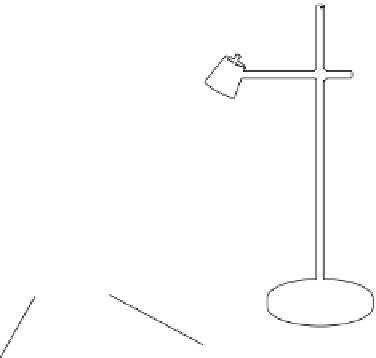Geoscience Reference
In-Depth Information
Area of solar radiation
at high latitudes
Light strikes
vertically
Light strikes
at an angle
Incoming
solar
radiation
Larger area of
illumination
Small area of
illumination
(a)
Area of solar radiation
at low latitudes
(b)
Figure 3.3 Interaction of solar radiation and the curved Earth.
(a) You can use a desk lamp to show that light striking a surface at an
angle illuminates a larger area (and is more diffuse) than light striking the surface vertically. (b) Solar radiation strikes Earth most directly at
low latitudes because the Sun angle is high, resulting in concentrated solar radiation in these regions. In contrast, solar radiation is more
diffuse at high latitudes because the surface curves away from the radiation and the Sun angle is relatively low.
Sun's rays strike Earth's surface. In general, the Sun angle is
relatively high at low latitudes and becomes progressively less
toward the poles because the Earth's surface is curved. The net
effect of this variation is that the solar energy received at higher
latitudes is spread over a relatively large surface area compared
to the same amount of energy received at lower latitudes. As a
result, the amount of incoming energy per unit area is relatively
low in areas where the Sun angle is low.
Figure 3.3 illustrates this difference. Lower latitudes
generally receive more intense solar radiation because the
Sun angle is high (between 75° and 90°). The point on Earth
where the Sun's rays are perpendicular to the surface (Sun
angle = 90°) at any given point in time, and therefore most
intense, is known as the
subsolar point
. Higher latitudes, in
contrast, receive less intense radiation because the Sun's rays
hit the Earth's surface at angles much less than 90° (a more
oblique angle) due to the Earth's curvature. You can explore
this relationship yourself by shining a desk lamp onto a sur-
face, as in Figure 3.3a, both directly and at an angle. Note
that the light is spread more diffusely when shone at a lower
angle than when the angle is 90°. The Earth's curvature has an
analogous effect on incoming solar radiation, which, in turn,
contributes greatly to many geographic patterns on Earth, in-
cluding atmospheric circulation and the global distribution of
climate, vegetation, and even soils.
Earth's Orbit Around the Sun
Let's now turn to the character of Earth's orbit. As Earth
revolves around the Sun, it moves in a counterclockwise
direction relative to a view above the North Pole on a flat
(imaginary) plane referred to as the
plane of the ecliptic
(Figure 3.4). Although it may be difficult to visualize this
plane, imagine that the Sun is in the middle of a large, round
cake pan. If the planets were marbles on the cake pan, they
would roll around the Sun only on the surface of the pan, not
above or below it. In a very similar way, Earth orbits the Sun
on a flat plane, except that the plane of the ecliptic passes
through the center of Earth rather than beneath it, as marbles
do on a cake pan.
It takes about 365 days (365.24 days, to be exact) for Earth
to make one full revolution around the Sun. In comparison,
Pluto requires 248 of our years to complete one orbit. Early
astronomers who calculated Earth's orbital time length config-
ured our calendar year to reflect this period of time. You may
wonder why February has a variable number of days, depend-
ing on the year. Normally, February contains 28 days. Every
fourth year (known as
Leap Year
), however, February con-
tains 29 days. This day is added in order to correct for the un-
even length of time (365.24 vs. 365 days) it takes for Earth to
complete its orbit.
Subsolar point
The point on Earth where the Sun angle is
90° and solar radiation strikes the surface most directly at any
given point in time.
Plane of the ecliptic
The flat plane on which the Earth trav-
els as it revolves around the Sun.






























































